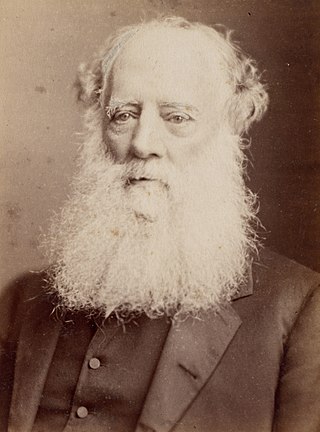
Sir Redmond Barry,, was a colonial judge in Victoria, Australia of Anglo-Irish origins. Barry was the inaugural Chancellor of the University of Melbourne, serving from 1853 until his death in 1880. He is arguably best known for having sentenced Ned Kelly to death.

Princes Highway is a major road in Australia, extending from Sydney via Melbourne to Adelaide through the states of New South Wales, Victoria and South Australia. It has a length of 1,941 kilometres (1,206 mi) or 1,898 kilometres (1,179 mi) via the former alignments of the highway, although these routes are slower and connections to the bypassed sections of the original route are poor in many cases.

William Branwhite Clarke, FRS was an English geologist and clergyman, active in Australia.

Intercolonial cricket matches were the first-class cricket matches played between the various colonies of Australia prior to federation in 1901. After federation, they became known as Interstate matches. By the 1880s regular intercolonials were being played, generally with intense rivalry. Matches against visiting professional teams from England also attracted public interest.

The East Melbourne Cricket Ground was a grass oval sports venue located at the corner of Wellington Parade and Jolimont Parade, in East Melbourne, Victoria, Australia. Now part of Yarra Park and being adjacent to the Melbourne Cricket Ground, the site is best known for playing host to many sporting events during the city of Melbourne's early existence, consisting mainly of cricket and Australian rules football, although the ground occasionally hosted soccer matches.

Australian rules football in England is a team sport and spectator sport with a long history. The annual match between Oxford and Cambridge Universities is the longest running Australian rules fixture outside Australia. The current competitions originated in 1989 and have grown to a number of local and regional leagues coordinated by AFL England. In 2018, these regional divisions were the AFL London, AFL Central & Northern England and Southern England AFL.

Australian rules football in New South Wales describes the team sport of Australian rules football as it is played and watched in the Australian state of New South Wales (NSW). It dates back to the colonial era in 1866 with organised competition being continuous since the 1880s. Today, in several regions of the state, the sport is moderately popular, including Broken Hill near South Australia, and the Riverina and the South Coast near Victoria. However rugby league in New South Wales remains far more popular elsewhere, particularly in Sydney. AFL NSW/ACT is the governing body and includes the Australian Capital Territory.

Princes Bridge, originally Prince's Bridge, is a bridge in central Melbourne, Australia that spans the Yarra River. It is built on the site of one of the oldest river crossings in the city, and forms a gateway into the central city from the south. The bridge connects Swanston Street on the north bank of the Yarra River to St Kilda Road on the south bank, and carries road, tram and pedestrian traffic. The present bridge was built in 1888 and is listed on the Victorian Heritage Register.

The Melbourne International Exhibition is the eighth World's fair officially recognised by the Bureau International des Expositions (BIE) and the first official World's Fair in the Southern Hemisphere.

The Sydney International Exhibition was established headed by Lord Augustus Loftus and took place in Sydney in 1879, after being preceded by a number of Metropolitan Intercolonial Exhibitions through the 1870s in Prince Alfred Park.
The 1877 Victorian Football Association season was the first in which the Australian rules football competition in Victoria was run under a properly constituted administrative body. The Association was formed with the view to governing the sport via a collective body, made up of delegates representing the clubs. It was the second such body to have been formed; the South Australian National Football League having been formed just 17 days prior to the VFA.

Henry Beaufoy Merlin (1830–1873) was an Australian photographer, showman, illusionist and illustrator. In the 1850s he worked as a theatrical showman and performer in Sydney, Newcastle and Maitland. In 1863 he was the first person to introduce Pepper's ghost to Australia. After this, he took up photography and between 1869 and 1872 turned the American Australasian Photographic Company into one of the most respected studios in Australia. Between 1872 and 1873 he worked extensively documenting the goldfields and mining towns of New South Wales. In 1873, as an employee of Bernhardt Holtermann, he photographed Sydney and many rural New South Wales towns. He died on 27 September 1873.
Henry Heath Glover, was an Australian artist and lithographer, commonly known as Harry Glover, or Henry Glover, jun. while his father was alive.
Elizabeth Gray was an Irish artist, etcher, and amateur photographer.

The Victorian Intercolonial Exhibition world's fair was held in Melbourne, Colony of Victoria between 2 September and 16 November 1875.
Louis Australia Whyte was an Australian amateur tennis player and golfer. He won the Intercolonial Lawn Tennis Championships twice, in 1881 and 1883. In golf he won the Victorian Golf Cup in 1894 and the Australian Amateur in 1900.
James Churchill Fisher, generally known as J. C. Fisher or J. Churchill Fisher was an Australian singing teacher and composer. He is best known as an advocate of the Tonic Sol-fa system of music teaching, and was responsible for the system's introduction to Australia.

Alfred Clint was an Australian cartoonist and theatrical scene painter and member of a notable family of artists.
George Alfred Russell was an Australian businessman involved in several business ventures, finally acting as Australian manager for the North British Insurance Company.













